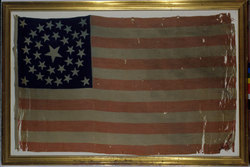34 Star United States Parade Flag.
Before the Civil War, use of the United States flag by the general public had been limited. Major businesses, government buildings, and private ships flew the Stars and Stripes, but except during political campaigns the general public rarely displayed the flag. That changed suddenly after military forces of South Carolina and the Confederacy opened fire on Fort Sumter in the harbor of Charleston, South Carolina, in April 1861. The nation and, by extension, the national flag, had been insulted and physically attacked. Outside the South, essentially the whole public rallied to the Stars and Stripes, such that flag manufacturers found it difficult to keep up with the demand for flags. Defense of the Union and all it stood for was expressed by flag display and the public for the first time clamored to own flags personally. Flags printed either on cotton muslin or the more expensive silk (such as is shown here) were put into widespread production in 1861 and continued to be made in quantity throughout the War.
This is a flag of an unusual pattern because of the odd star added in the upper right corner of the canton of this important flag. A flag-printing block was designed for 33 stars, but was modified to print 34 star flags. A rare surviving flag such as this shows that people modified their flags with the inclusion of new states instead of making an entirely new flag. Flag making in this period was still, for most part, a cottage industry with the mechanized industry just beginning with the advent of the sewing machines about a dozen years before this flag was made (circa 1860/1861).
The silk field is printed with 13 horizontal alternating red and white stripes, each about 1.75 inches wide. The top stripe is red and the bottom stripe is red. Also printed onto the field, and extending through seven stripes from the top, is a dark blue silk canton (union) 13 inches wide on the fly x 12.5 inches, bearing 34 stars, 1.5 inches across (middle star 3.5 inches across), printed on the obverse side, but not on the reverse side.
The star pattern reflects the commercial modifications of the press blocks used to create this flag from a 33 star pattern to a 34 star pattern at the beginning of the Civil War. The pattern consists of a larger center star surrounded by an inner ring of ten stars and an outer ring of eighteen stars. One more star graced each corner of the canton; however, the press block was altered in 1861 to accommodate a thirty-fourth star just below the upper fly corner of the canton. The flag is printed with minor hand stitching.
When the entire Star Spangled Banner Collection was acquired into the Zaricor Collection, this was one of the very few flags framed out of a total of over 225 flags acquired over a year's time from the museum. This flag was not only framed, it was the only one in a gold frame. It is assumed that this flag's history must have been notable, for it to be one of very few flags framed in the museums' collection.
Exhibition History:
First Presidio Exhibit
(ZFC0176)
34 Star United States Parade Flag
Provenance: Acquired by the Zaricor Flag Collection (ZFC0176) in 1996 from the Star-Spangled Banner Flag House Collection of Baltimore, MD
ZFC Important Flag
Item is Framed
















